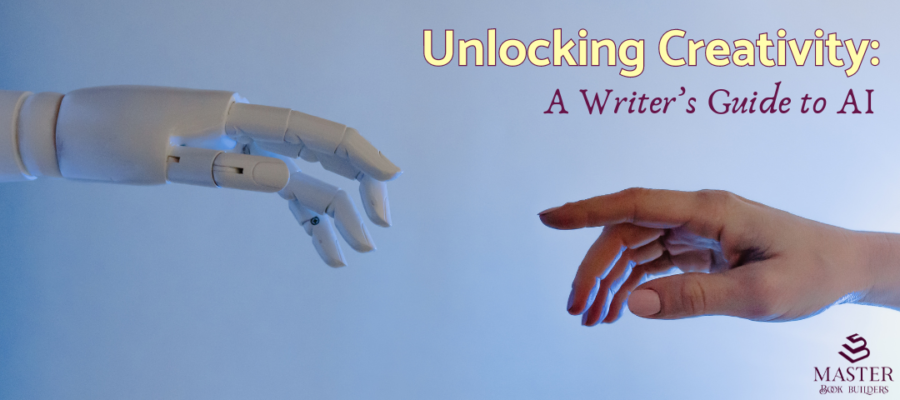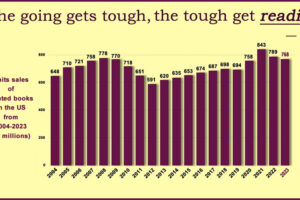Unlocking Creativity: A Writer’s Guide to AI
Harnessing the power of artificial intelligence (AI) has become a game-changer for authors seeking to build real success in today’s multi-media world of social, email, video, podcasting, and Zoom book launches. The landscape is fraught with confusion and misinformation.
I thought I’d take a moment today to discuss how to use AI properly as a writer of any kind of book. I won’t be focused on nonfiction or fiction. This is about sharing insight you can use in whatever type of book you’re writing. And it covers both writing and marketing.
CONTENT GENERATION: AI-powered tools like ChatGPT can assist authors in generating ideas, brainstorming plot points, and even drafting entire chapters. The key is to understand prompts.
A prompt is the question you are asking AI to help you with. For instance, if you are writing a business book on business plans, you might ask ChatGPT or your favorite AI tool:
“writing as an established business professional in <your industry> outline 20 points a new entrepreneur would need to address when creating a business plan”
You can also ask it for titles. Or an outline of your book to turn into a Table of Contents.
Understand that you will need to edit, rearrange, cut and paste, and ultimately change the AI results into your own voice. While AI can imitate you, it cannot be you. (read more at the link here)
My friend, John Jantsch from Duct Tape Marketing, offers a comprehensive guide to AI Prompts in which he recommends working with AI to create a 90-Day Editorial Guide titled: (minor edits were made to this which is from Duct Tape Marketing: AI Prompts for Developing a Marketing Strategy)
The Ultimate Guide to <problem you solve>: (prompting AI like this)
- Acting as a content marketer for <your industry or brand> create a detailed outline with descriptions for each element for a 90-Day calendar, including possible blog posts, social posts to Facebook (and whatever other channels you have), and include email newsletter topics.
- Add more detail to each tactic
Notice #2. Prompting AI to do more is how you flesh out the ideas. I often ask it to include specific keywords, also.
Learning how to write and even teach people how to write prompts is becoming big business these days. Maybe you should write a book on that.

AI is being used to create plot analyses and character development and offer insight into improving the writing or readability of your manuscript. Just know that every piece of content AI shares is a suggestion. Do not think AI can write your book for you. As mentioned in previous posts, AI has never held a baby, walked on a beach, cried at a funeral. It can only imitate human emotion. It doesn’t have any of its own as you do. And that is what makes a book readable – the emotion of story sharing.
Here are some other areas AI can be a big help writing and marketing your book. Whether you tackle these yourself or get help (we know people, ask us if you need help), consider some of these as you write your book.
Language Enhancement: AI can also improve the quality and clarity of your writing. Grammar-checking tools like Grammarly (a favorite of mine, except when it fights with the Word grammar tool over comma placement!) and language enhancement platforms like ProWritingAid use AI algorithms to identify errors, suggest improvements, and enhance the overall readability of your manuscript.
Note the word ‘enhance’ in the sentence above. I use Grammarly and it sometimes makes useful suggestions but because it’s AI, it does not account for nuances, voice, or tone. In my role as developmental editor, I rarely accept Grammarly’s suggestions for changes to whole sentences or paragraphs. It does get me to reread content that I may then change, accordingly, always writing in my own words (which the author will approve or rewrite again themselves).
Chatbots and Virtual Assistants: AI-powered chatbots and virtual assistants can automate customer service inquiries. Again, I recommend using these in conjunction with a real person. AI providing information about the author’s book, and facilitating conversations directly on social media platforms must be reviewed by a real person who understands the nuances of human speech.
Audience Analysis: Identifying your target audience is step #1 for successful book marketing. It’s not everyone on the planet. It’s not businesswomen. It’s not businesswomen who are entrepreneurs. It’s deeper than that. Perhaps it’s businesswomen who are coaches. But what kind of coaches?
AI tools can help analyze reader demographics, preferences, and trends to help you tailor content and marketing strategies that will resonate with your chosen audience.
Here’s how AI can help you gain deeper insights into your readership:
- Demographic Profiling: AI-powered tools can quickly analyze large datasets to discover demographic trends among your readers, including age, gender, location, and socioeconomic status.
This answers the question: who is my reader? Learn more about them using AI.
- Behavioral Analysis: This is a phenomenal use of AI.
Using AI algorithms, you can analyze user behavior and engagement patterns across various platforms, such as social media, websites, and online forums.
I find this genius, except it’s not. It’s merely a tool, an AI tool, tracking metrics such as browsing habits, content consumption, and interaction frequency into how your chosen audience interacts with your kind of content and what topics or themes resonate most strongly with them.
- Sentiment Analysis: I think this one is great!
To gauge sentiment and emotional response towards your book or related topics, it can’t hurt to ask whatever AI tool you use to analyze user-generated content, such as reviews, comments, and social media posts. By monitoring these trends over time, you can adjust your marketing strategy accordingly.
- Predictive Analytics: How interesting is this? I would not have thought of it, but I am sure people like my friend Raoul Didisheim is all over this.
AI-driven predictive modeling can forecast future trends and behaviors based on historical data and patterns. By leveraging predictive analytics, you can anticipate changes in reader preferences, market demand, and competitive landscape, allowing you to stay ahead of the curve and adapt your marketing strategy proactively.
AI is here to stay, folks. Incorporating this tool in both your writing and your marketing can bring success to you and your book faster than trying to do it the old fashioned way – by sending press releases and posting to your social channels.
Of course you do those, also, but tap into AI to write the press release and give you the best suggestions for your social posts.
Here are two resources I recommend for learning more about tapping into the power of AI for books:
B.L. Ochman – This woman has been using technology for as long as I’ve known her, more than 20 years. She’s a key player in AI and training, right now.
Denise Wakeman – The AI Success Club is an affiliate of ours and will help you leverage your AI skills faster and better than you can on your own.
I will end by saying I’ve learned a lot from both B.L. and Denise and I used ChatGPT to help write this newsletter.
Any questions? Connect with me on LinkedIn. Tell me about your book and what scares you most about AI in the world of writing and publishing today.






Leave a Reply